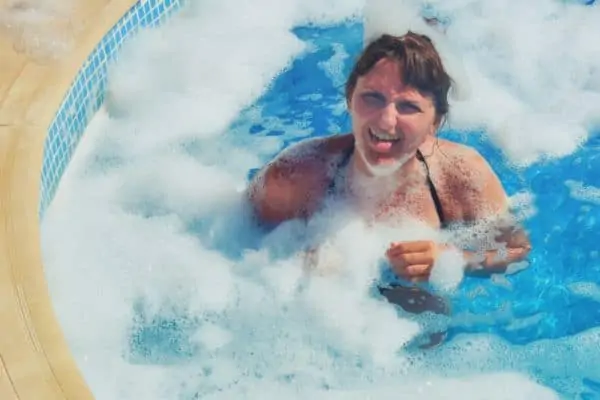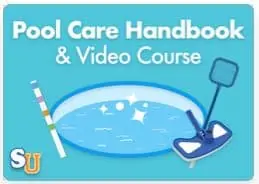Although children may think it is fun, having pool foam is not a great thing. You may wonder why is my pool foaming, which can happen very quickly.
Pools can start foaming when the chemicals are unbalanced, unwanted chemicals have entered, or you have added algaecides into the water. To stop the pool from foaming, you may have to rebalance the chemicals, do a complete backwash cycle, or leave the foam to dissipate with time.
Learning why your pool may be foaming and what you can do in the future to prevent it is important to its overall health.


Why does my pool have foam?
The reasons you may have foam on the surface of your pool can be extremely varied.
Bubbles on top of pool water can be caused by a number of factors. The following will help to try and diagnose the reason or reasons that your pool may be foaming.
Pool foam is made out of three things:
- Water
- Air
- Surfactants
While none of those elements are individually a problem, when they’re mixed with other residues, they create the foam and that is a problem. The surfactants (soap, oils, etc.) are the culprit when it comes to making pools foam. Surfactants are molecules that are sticky by nature, lower the liquid’s surface tension, and make it easier for oil-like substances to mix with water.
So let’s look at these individually:
Algaecide
Ending up with your pool water foamy after algaecide is added to your pool is actually very common.
This is particularly true if you have just added algaecide as a precaution to prevent algae growth.
When adding algaecide to a pool it can be normal to get algaecide bubbles that cause a thin layer of foam to form across the pool’s surface. You should read the instructions on the packaging and not add too much algaecide.
Soaps
It can be from hair care products, soaps used to clean pool toys, or even a special soap you used to clean around the pool, but soap is the most common cause. These products are made to be foamy, obviously, and when enough enters the pool’s water, it will start creating layers of foam on the surface.
Also any detergent used to wash swimwear can get in the pool and contribute to surfactant accumulation.
Personal care products
Creams, lotions, and ointments that people use on their skin to keep it soft, safe from sunburn, and everything else will cause foaming once the ratio reaches the right levels.
Fortunately, this is generally only a problem when you have many people entering the pool each day for a long time. Usually, you will see foaming caused by this at public pools, whereas pools at home are not exposed to enough of these chemicals to cause foaming to occur.
If people shower before entering the pool this can help reduce this.
Human body
The human body is obviously an unavoidable one, but the truth is the human body produces a lot of different things. Dead skin cells, fatty acids, sweat and more are human body byproducts that can end up in the pool while swimming.
Nothing can be done about this, and it is why sanitizing chemicals and proper maintenance are important for pool water.
Household cleaners
These can get into the water in a pool, often when you are trying to clean something around the pool, such as using a cleaning product to clean the housing of the pumps and filter or cleaning the decking or paving around the pool. Not all of these cleaners can cause foaming, but they can mess up the other chemicals in the pool.
When using cleaners near the pool, never hose off whatever you may be working on as this may wash some into the pool. Instead, use a damp cloth to wipe away the cleaner; this should prevent unwanted chemicals from entering your pool and creating a strongly scented foamy mess.
Chemical imbalance
The chemicals in your pool are meant to prevent foaming from happening. However, if the chemicals are not balanced properly then foaming can occur.
Testing your water and keeping the chemical levels correct should be part of your regular maintenance routine and, if done correctly, should be enough to stop forming from occurring.

How to get foam out of pool
While there can be many causes of a foamy pool, as detailed above, figuring out what is causing the foam in your pool is not always simple or obvious. The key is to systematically try each step to try to eliminate the problem.
Chemical rebalancing
The first thing to do, whenever you have a foaming problem, is to check the water in your pool using a good test system or take a sample of your pool water to your local pool supply company for their analysis.
Add whatever chlorine and other chemicals that may be needed to bring the chlorine, pH and total alkalinity readings to the level they should be. Then give the pool a day or two to settle down to see if the foaming persists.
Use anti-foam chemicals
You can purchase anti-foam products such as Pool & Spa Defoamer. This is a kind of chemical that gets rid of the foam quickly. This is a great fast option but you must always be mindful that when you use chemicals you are turning the water into a bit more of a chemical soup.
If you are going to add anti-foam products, you need to wait a few days. If you know that people will be swimming later in the day, you should wait until after; chemicals can work miracles on a pool, but timing is imperative.
Anti-foam chemicals do not address permanently the problem, however. Anti-foam chemicals can keep foams away for up to 24 hours.
Backwashing
Backwashing the pool sand filter or removing and cleaning the filters, depending on your set up, may help to remove any of the foaming chemicals that could be stuck inside the filters. If you allow a few inches of water to be drained from the pool and add in fresh water, it will also dilute the foaming chemical in the water, causing less foam to develop.
I would recommend doing a quick backwash anyway when you are starting to treat for the foaming issue that you may have. It will do no harm anyway.
Leave the foam
This is most often the best way to solve the problem, switching off the pump system, adding some chlorine, and leaving the foam to dissipate. This kills off anything that may be causing the foam and allows the current foam to disappear, creating a nice clean pool.
How to get rid of algaecide foam in pool
If you have added algaecide and now have foam then the best course of action is to do nothing as it is unlikely to last very long. You could use a fine net to scoop out as much foam as possible and also turn off any fountains or waterfalls for a while as these will increase the amount of foam.
A drastic step would be to empty and refill the pool but that is expensive, time-consuming as well as lots of work.
Can you swim in a pool with foam?
Provided your chemicals are balanced, it should be safe to swim in a pool that has some foam on the surface. So use a test strip or some other pool water testing system and if the readings are within normal then go ahead and swim.
Conclusion
You may find your pool foaming for many reasons, and each one can be solved with a few simple steps. The most common solution for a foaming pool will be to leave it and let the pool chemicals do their job breaking down the foam.
My top 3 pool cleaning tools
These are the pool cleaning tools I have found the most useful since I have had my pool.
Step and corner vacuum brush
This is a really useful tool for getting into the areas that a standard vacuum head simply cannot reach. Aquatix Pro Pool Step & Corner Vacuum Brush
Leaf rake net
If, like me, you get plenty of leaves at the bottom of your pool then a good leaf rake/net is a must. The Stargoods Pool Skimmer Net gets under the leaves easily.
Robotic pool cleaner
These are quite expensive and it was a number of years before I bit the bullet and bought one. I have never regretted it. The Dolphin Nautilus CC Plus is the most recommended pool cleaning robot on all of the pool forums. It not only cleans the bottom of the pool but also the sides and the waterline.







Leave a Reply